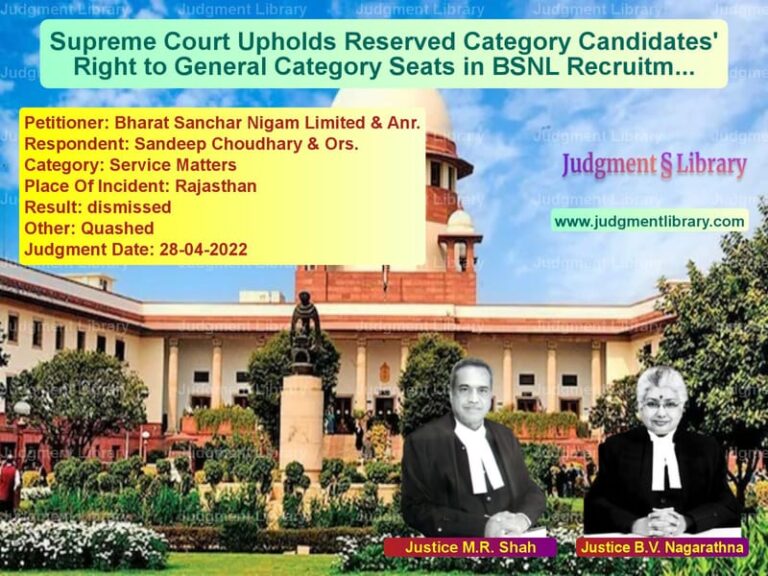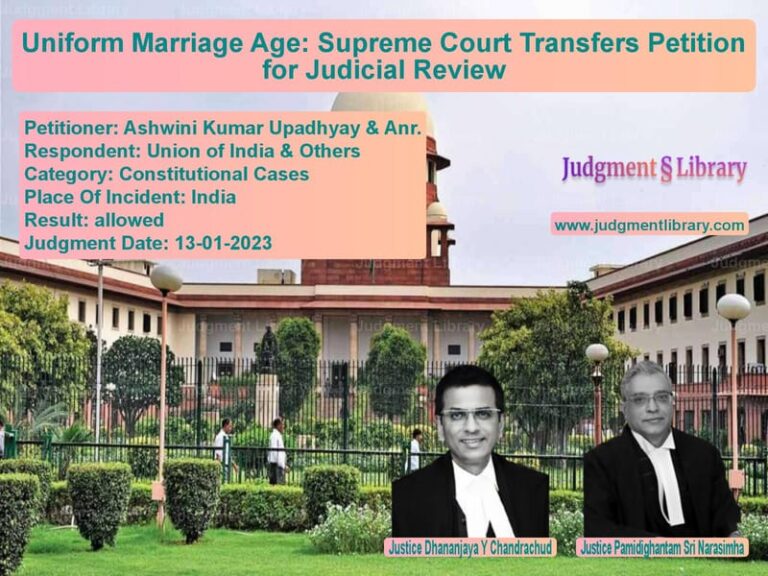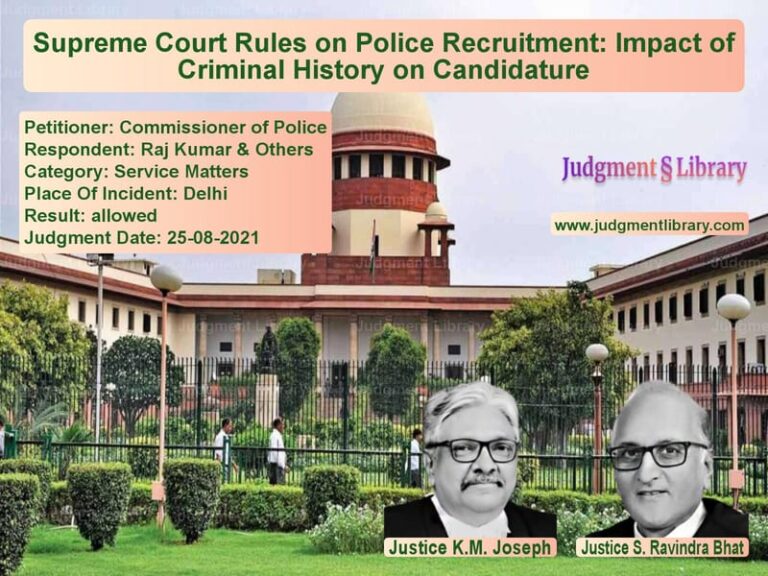Supreme Court Acquits Accused in Gujarat Murder and Robbery Case Due to Lack of Conclusive Evidence
The Supreme Court of India recently delivered a significant ruling in a criminal appeal that reversed the conviction of four individuals accused of murder and robbery. The case, which originated from an incident in Gujarat in 1990, saw a protracted legal battle spanning over three decades, culminating in the Supreme Court’s final decision to acquit the accused due to lack of conclusive evidence.
Background of the Case
The case revolved around the murder of a jeep driver, Bharatbhai, whose body was discovered on March 1, 1990, in a field in Dangiya village, Gujarat. The prosecution alleged that the accused—Thakore Laxmansing (A1), Thakore Pravinsing (A2), Thakore Umedsing (A3), and Thakore Khemsing (A5)—had hired the victim’s vehicle, subsequently killed him, and looted his jeep.
Following the complaint by the victim’s father, an FIR was lodged at Gadh Police Station, and an investigation was launched. On March 2, 1990, PSI J.N. Chaudhary of Sardarnagar Police Station reportedly stopped a rapidly moving jeep near Ahmedabad, which led to the arrest of A1 while the others managed to escape. During interrogation, A1 allegedly confessed to the crime and named his co-accused.
The accused were charged under Sections 302 (murder), 396 (dacoity with murder), and 392 (robbery) of the Indian Penal Code (IPC). The trial court acquitted them of murder charges but convicted them for robbery, sentencing them to ten years of rigorous imprisonment.
High Court’s Ruling
The Gujarat High Court, in 2015, overturned the trial court’s acquittal and convicted the accused under Sections 302 and 396 IPC, sentencing them to life imprisonment. The court relied on circumstantial evidence, including the alleged confessions and the presence of blood-stained clothing and weapons recovered at the accused’s instance.
Following this, the accused appealed to the Supreme Court, challenging the legality of their conviction and asserting that the prosecution had failed to establish their guilt beyond a reasonable doubt.
Arguments by the Appellants
- The appellants contended that the case was based purely on circumstantial evidence, with no direct proof linking them to the crime.
- They argued that the trial court had correctly acquitted them of murder charges, and the High Court erred in overturning the acquittal without substantive new evidence.
- The alleged confessions made to the police were inadmissible under Sections 25 and 26 of the Indian Evidence Act, as they were not recorded before a magistrate.
- The weapons and blood-stained clothing reportedly recovered from the accused were not conclusively linked to the victim, as no forensic report matched the blood samples.
- The police had not followed proper procedures while collecting and preserving evidence, leading to potential contamination.
State’s Defense
- The prosecution maintained that the accused were last seen with the victim and were found in possession of the stolen jeep, which was enough to establish their guilt.
- The High Court had correctly interpreted the circumstantial evidence to conclude that the accused had committed the crime.
- The alleged discovery of blood-stained clothing and weapons was presented as proof of their involvement.
Supreme Court’s Observations
The Supreme Court carefully analyzed the case, emphasizing that circumstantial evidence must form a complete chain, leaving no doubt about the accused’s guilt. The Court made the following key observations:
- The prosecution’s case primarily relied on the alleged confession of A1, which was inadmissible under the Evidence Act.
- The police failed to establish that the weapons recovered at the accused’s instance were used in the crime, as no forensic evidence linked them to the victim.
- The gap between the accused being last seen with the victim and the discovery of the body was significant, weakening the prosecution’s theory.
- “The circumstantial evidence presented by the prosecution fails to establish a complete chain linking the accused to the murder.”
Precedents and Legal Standards Applied
The Supreme Court referred to landmark cases such as Sharad Birdhichand Sarda v. State of Maharashtra, which laid down the golden rules for circumstantial evidence:
- The circumstances from which the conclusion of guilt is drawn must be fully established.
- The facts must be consistent with only one hypothesis—that the accused is guilty.
- The evidence should exclude every other possible hypothesis except guilt.
- The circumstances must form a complete chain without any reasonable doubt.
The Court found that the prosecution failed to meet these criteria and, therefore, the conviction could not be sustained.
Judgment and Conclusion
The Supreme Court allowed the appeal and set aside the High Court’s judgment, restoring the trial court’s acquittal. The Court held:
“Convictions cannot be based on mere conjectures and suspicions. The prosecution has failed to establish an unbroken chain of evidence proving the guilt of the accused beyond a reasonable doubt. The benefit of doubt must be given to the accused.”
The Court further directed the immediate release of the accused, provided they were not required in any other case.
Legal Implications
This ruling reinforces the principle that circumstantial evidence must meet strict legal standards before leading to a conviction. It highlights the need for forensic corroboration in cases relying on blood-stained weapons or clothing. The decision serves as a caution against overturning acquittals without strong new evidence.
The judgment also reiterates that appellate courts must not interfere with trial court acquittals unless there is clear evidence of a miscarriage of justice.
Conclusion
The Supreme Court’s verdict in this case underscores the importance of procedural fairness and adherence to legal principles in criminal trials. By quashing the High Court’s decision, the Court has reaffirmed that convictions must be based on reliable and legally admissible evidence. This ruling will likely serve as a precedent in future cases involving circumstantial evidence.
Petitioner Name: Thakore Umedsing Nathusing.Respondent Name: State of Gujarat.Judgment By: Justice B.R. Gavai, Justice Sandeep Mehta.Place Of Incident: Banaskantha, Gujarat.Judgment Date: 22-02-2024.
Don’t miss out on the full details! Download the complete judgment in PDF format below and gain valuable insights instantly!
Download Judgment: thakore-umedsing-nat-vs-state-of-gujarat-supreme-court-of-india-judgment-dated-22-02-2024.pdf
Directly Download Judgment: Directly download this Judgment
See all petitions in Fraud and Forgery
See all petitions in Bail and Anticipatory Bail
See all petitions in Judgment by B R Gavai
See all petitions in Judgment by Sandeep Mehta
See all petitions in allowed
See all petitions in Quashed
See all petitions in supreme court of India judgments February 2024
See all petitions in 2024 judgments
See all posts in Criminal Cases Category
See all allowed petitions in Criminal Cases Category
See all Dismissed petitions in Criminal Cases Category
See all partially allowed petitions in Criminal Cases Category







